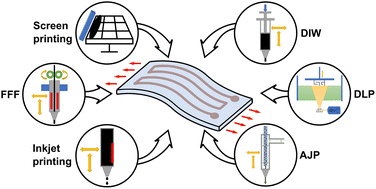Printed flexible mechanical sensors†
Abstract
Flexible mechanical sensors (e.g., strain, pressure, and force) fabricated primarily by printing technologies have emerged and evolved promptly in the past several years. 2D and 3D printing approaches enabled rapid prototyping of various flexible mechanical sensors that have demonstrated their unique applications in fields including robotics, human–machine interfaces, and biomedicine. Research efforts have primarily been focused on experimenting with different materials, device configurations, and sensing mechanisms to achieve better sensing performance. While great progress has been made, this field is still in its infancy where most research is exploratory; and even the performance standards and long-term objective/vision of these sensors are not clear. In this review, the state-of-the-art of three types of printed flexible mechanical sensors will be discussed and analyzed in terms of their fabrication methods, types of sensing materials and mechanisms, and challenges for future development.

- This article is part of the themed collections: Nanomaterials for printed electronics and Recent Review Articles


 Please wait while we load your content...
Please wait while we load your content...